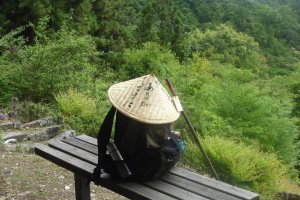Pilgrimage – “a long journey or search of great moral significance”, according to Wikipedia, is usually associated with a religious or spiritual quests.
The Kumano area, a mountain range full of scenic beauty, traditions and mystery, is often referred to as the spiritual heartland of Japan.
For over 1,000 years Kumano has attracted Japanese worshippers and seekers and old trails, more or less intact, cross-cross the Kii-Peninsula leading to some sacred sites well-worth a detour from the well-trodden “Golden Route” between Hiroshima and Tokyo that most visitors travel on.
Both the Nakahechi trail and the Kohechi trail lead to the Hongu Taisha, the Hongu Grand Shrine, which is one of the Kumano Sanzan, the Three Grand Shrines of Kumano, all sacred sites for the Japanese.
The Nakahechi trail offers a good introductory walk to the Kumano area as it takes only two days while walking along the Kohechi trail needs some more dedication and preparation and it takes four days.
Each day you ascend a peak and then you walk down the slopes into a valley where some settlements offer shelter overnight at a minshuku (B & B). After a long day walking, Japanese dinners served at the inns taste super delicious.
You will go to bed before 9pm as there is nothing much to do after dark. No neon light disturbs the pitch-black darkness outside and the quaking of frogs in the nearby rice fields will soon lull you into a deep sleep.
Mornings starts early with an opulent Japanese-style breakfast, after all, you need strength to tackle a peak each day. The friendly pension owners will also prepare you a bento (lunch box) and you better take it.
There are no convenience stores for a quick food-stop and no vending machines either along the Nakahechi and Kohechi trails.
The locals are friendly to pilgrims and hikers alike. Tiny old women, so old that they seem ageless, offer big smiles and kind words. Famers give you cold spring water from their wells and some fruits from their gardens before they continue with their daily routine of working in the fields.
You might feel disconnected from the rest of the world as even some mobile phones are out of reach of any network. Undisturbed by phone calls and email requests and not distracted by the visual overload that Japanese cities offer, you can appreciate nature’s sounds and the expanse of forest and mountains surrounding you.
Struggling up steep hills to get to the next mountain pass, one gets tired and sits down to rest at some lookout point. The serene beauty of the Kumano landscape eventually even stops the chatterbox inside us modern city slickers.
Thinking nothing anymore, one opens up and begins to see the multiple-shaded leaves of the greenery, the shadows casted by cotton-wool clouds on the mountain slopes and the graceful flight of an eagle high up in the sky. One hears the bumble-bees busily collecting nectar from the colorful scented blossoms of a nearby bush and the dreamlike barking of a dog in a distant place.
Sure you do not necessarily have to come to Japan to experience all this. However, this is the perfect place for anyone seeking a spiritual and cultural mountain retreat in Japan instead of a spa holiday in Bali or a beach holiday in Thailand.
Walking along the Kumano Kodo is recommended to anyone who likes hiking in the mountains with a breeze of cultural discovery and spiritual flair.
What’s more, I can also recommend the Kumano area to women travelers. I have walked the trails alone several times without having encountered any problems.


































